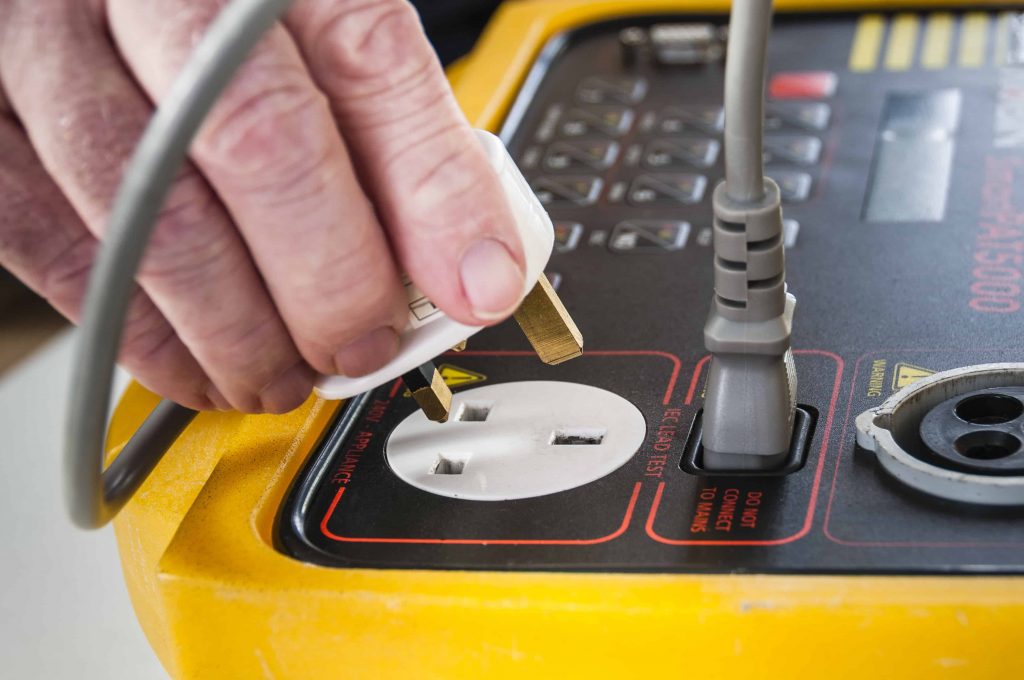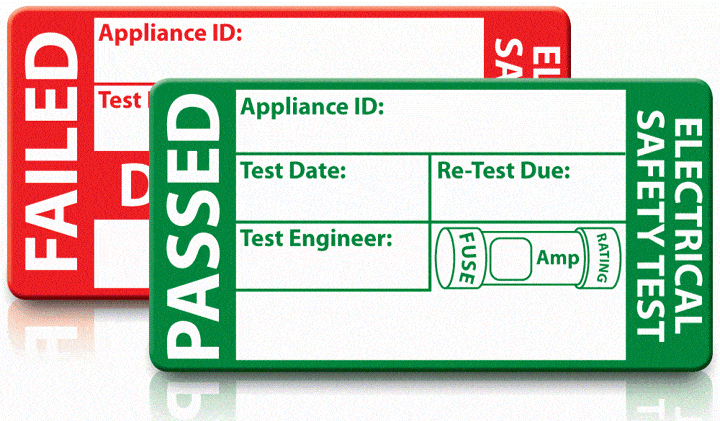PAT testing explained – everything you ever wanted to know about PAT testing (and a little bit more)
‘What is a PAT test?’ is a question we get asked all the time. So we’ve created a guide which answers your PAT testing questions in a simple and straightforward way.
When we get asked ‘what is a PAT test?’ we always take the time to understand exactly what our customer really wants to know about PAT testing.
Often we find that people are most interested in understanding PAT testing legal requirements.
So as well as answering the question ‘what is a PAT test?’, our guide below will also help you understand your business or industry’s likely legal obligations.
1. What is a PAT test?
A PAT test is a routine inspection of some types of electrical appliance to check they are safe to use. Its purpose is to prevent electrical accidents in the workplace.
A full PAT test should include both a visual inspection and a more in-depth check using specialist PAT testing equipment. This test includes earth continuity, lead polarity, and insulation resistance checks.
Some appliances only need a reduced test, called a PAT insulation test.
At the end of a PAT test, every appliance should be marked ‘passed’ or ‘failed’. Ideally there should be a record of the results.
Not all electrical items need to be PAT tested. We explain more in the section ‘Which items should be PAT tested?’ further down this page.
2. What does ‘PAT’ stand for?
‘PAT’ stands for ‘Portable Appliance Testing’.
There is no definition of what a ‘Portable Appliance’ is in the current legislation, however the standard interpretation is “any appliance that has a plug attached to it and plugs into a wall outlet”.
Because of this, the word ‘portable’ is a bit misleading. There are actually 7 categories of appliance which should be considered for PAT testing or, at least, visual inspections:
– Fixed appliances
– Stationary appliances
– IT appliances
– Moveable appliances
– Portable appliances
– Cables and chargers
– Hand Held appliances
We explain more about each of these categories in the section ‘What are the categories of electrical appliance in PAT testing?’ further down this page.
3. Is PAT testing a legal obligation?
PAT testing is not, in itself, a legal obligation.
However, current UK legislation states that businesses must maintain electrical equipment in a safe condition.
They also have a legal responsibility to ensure the safety of employees and the public.
Because PAT testing is one of the most effective ways to do this, particularly for high risk or large, complex environments, it has become a standard way of meeting this legal obligation.
If you would like to read the specific guidance concerning electrical equipment at work, you can find this in a number of pieces of legislation:
– The Health & Safety at Work Act 1974
– The Electricity at Work Regulations 1989
– The Provision and Use of Work Equipment Regulations 1998
– The Management of Health & Safety at Work Regulations 1999
4. What are the penalties if I don’t meet my legal obligations?
Depending on the severity of the situation, the penalty for not meeting legal obligations on electrical appliance safety can be as high as 2 years’ imprisonment, as well as an unlimited financial penalty.
5. Who is responsible for electrical appliance safety?
The ‘Employer’ is responsible for electrical appliance safety.
In larger businesses a ‘competent person’ is often appointed by the employer, whose role is to make sure the company is compliant.
6. Which items should be PAT tested?
There are 2 main factors which determine whether or not an item should be PAT tested:
– The electrical ‘class’ of the item
– The ‘category’ of the item
We explain more about these in the following sections.
7. What are ‘electrical classes’ in PAT testing?
Electrical appliances are mainly categorised as Class 1, 2 or 3, with Class 1 being the most dangerous and Class 3 the least dangerous.
The class of an appliance helps determine whether it needs to be PAT tested and to what degree. Class 1 appliances need a full PAT test, Class 2 appliances need a PAT insulation test, and Class 3 appliances don’t need to be PAT tested at all.
Class 1 appliances
This type of electrical equipment has only basic insulation and relies on an earth for protection.
Class 2 appliances
This type of electrical equipment has extra insulation and so doesn’t rely on an earth for protection, which makes it safer.
Class 3 appliances
Class 3 appliances are low voltage items and are the safest class of electrical appliance. Their charging leads may need to be PAT tested.
Examples of Class 1 appliances:
Class 1 appliances carry this symbol:

The following appliances are usually (but not always) electrical class 1:

Examples of Class 2 appliances:
Class 2 appliances carry this symbol:

The following appliances are usually (but not always) electrical class 2:
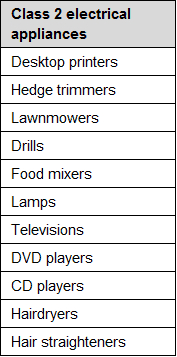
Examples of Class 3 appliances:
Class 3 appliances carry this symbol:

The following appliances are electrical class 3:
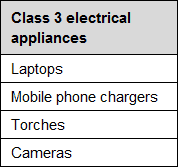
8. What are the ‘categories’ of electrical appliance in PAT testing?
As mentioned in section 2, there are 7 categories of electrical appliance which require some level of testing, either a simple visual inspection, or a full PAT test:
– Fixed appliances
– Stationary appliances
– IT appliances
– Moveable appliances
– Portable appliances
– Cables and chargers
– Hand Held appliances
The table below explains these categories in more detail:
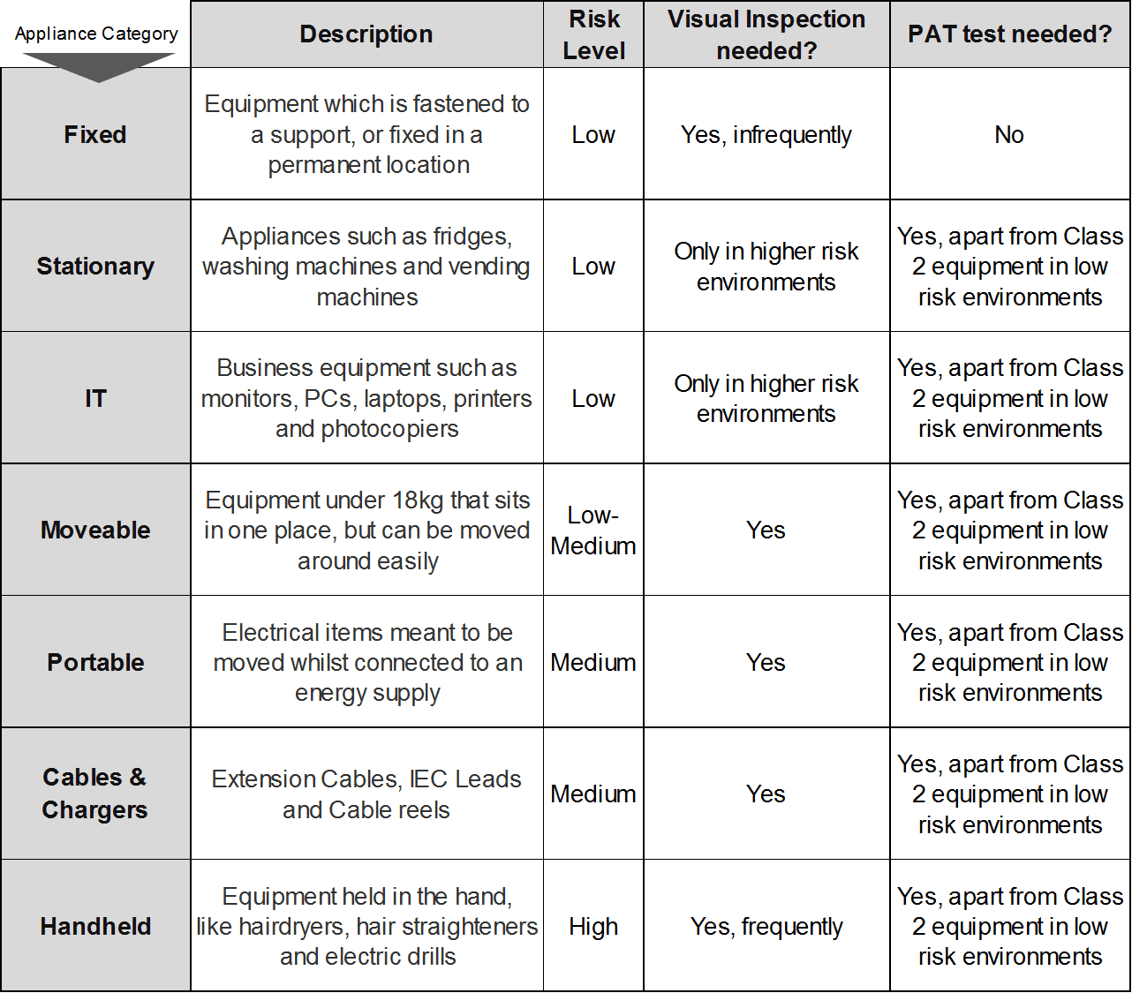
9. How often should items be PAT tested?
There are no specific rules for the frequency of PAT tests. However, the regulations say that the level of precaution taken should be ‘appropriate’ to the risk.
There are 3 main criteria which determine frequency of testing:
– the risk level of the working environment
– the electrical class of the appliance
– the category of the appliance
The Health and Safety Executive also recommends taking the following into consideration as necessary:
– manufacturer’s recommendations
– the age of the equipment
– frequency of use
– foreseeable misuse of the equipment
– effects of any modifications or repairs
– the history of the item
Our tables below tell you the recommended frequency of PAT testing and visual inspections based on the 3 main criteria.
Low Risk Environments:
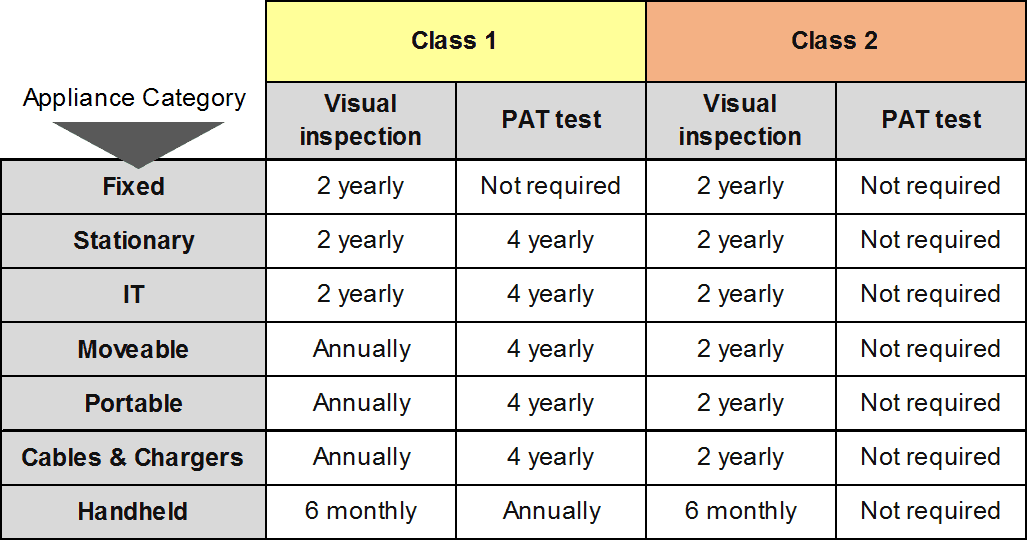
Low-Medium Risk Environments:
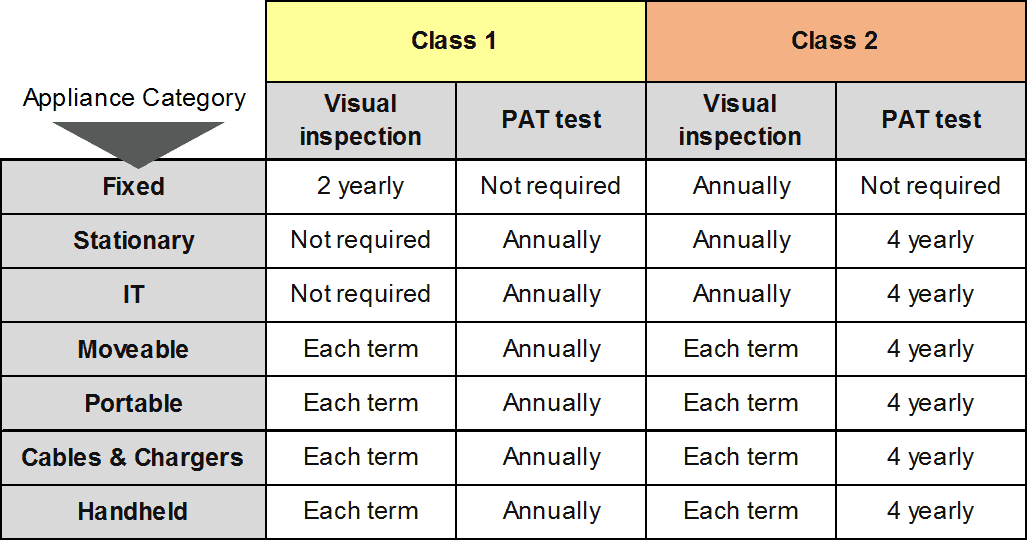
Medium Risk Environments:
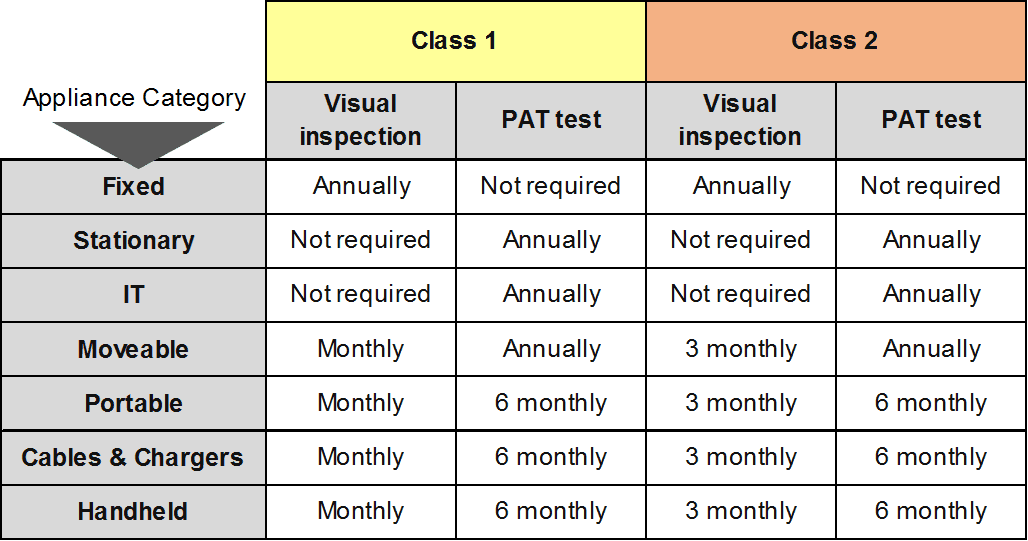
High Risk Environments:
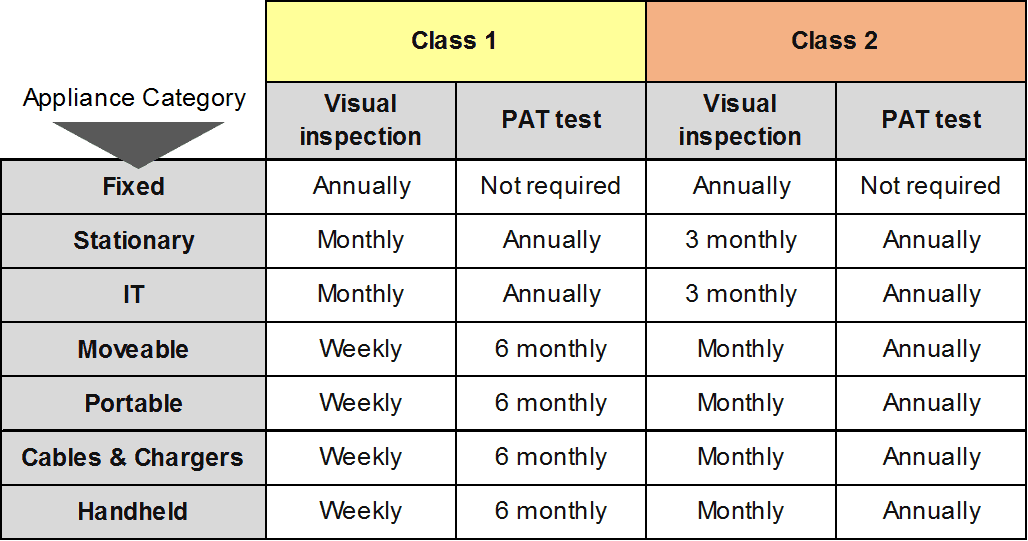
Extremely High Risk Environments:
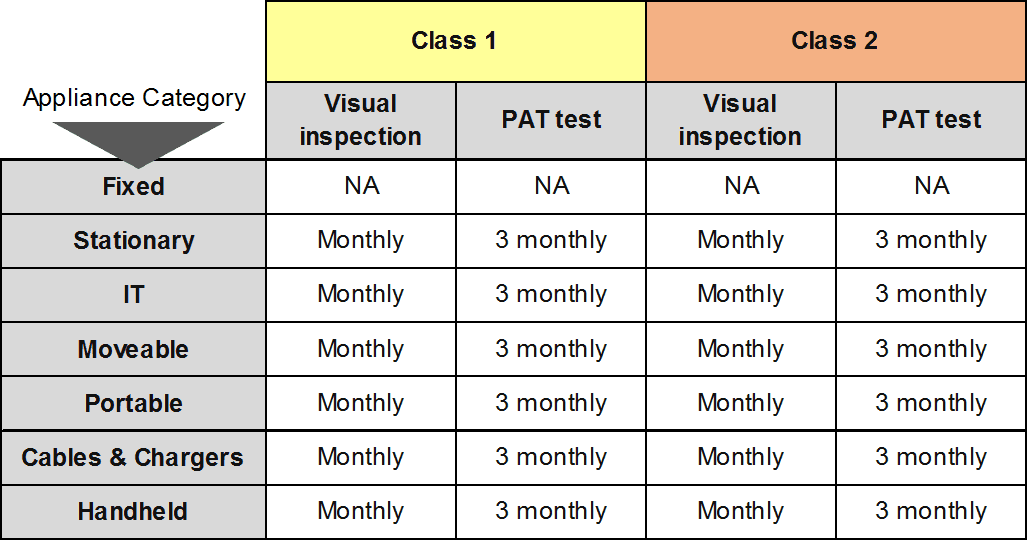
10. How do I know if my business is high, medium or low risk?
There are 3 main factors that are taken into account when assessing the electrical risk of a business for PAT testing:
- The risk level of the environment
- The type of equipment being used
- Who will be interacting with the equipment
For example, in an office setting where equipment is relatively static and there is a regular team using it day to day, there is much less risk than on a construction site.
On a construction site, hand-held, potentially dangerous equipment is in regular use and groups of workers tend to switch in and out and therefore the risk is much higher.
The table below gives an idea of the likely risk level of different types of business:
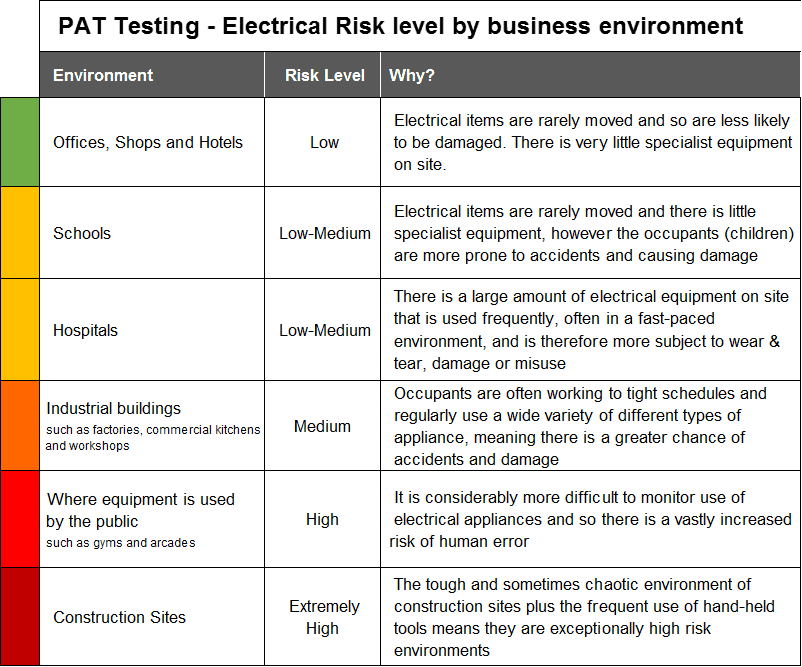
11. Can my business carry out its own PAT tests?
Yes, your business can carry out its own PAT tests, as long as the person doing the testing is a ‘competent’ person.
This means they should:
– have adequate knowledge of electricity
– have adequate experience of electrical work
– know how to carry out a visual inspection
– know how to carry out a PAT test
– understand potential hazards & precautions to take when PAT testing
– be able to decide whether it’s safe for PAT testing to continue
If you decide to do your own PAT testing we would strongly recommend taking a PAT testing course as it’s important to perform the PAT tests correctly.
You will also need to invest in some PAT testing equipment.
